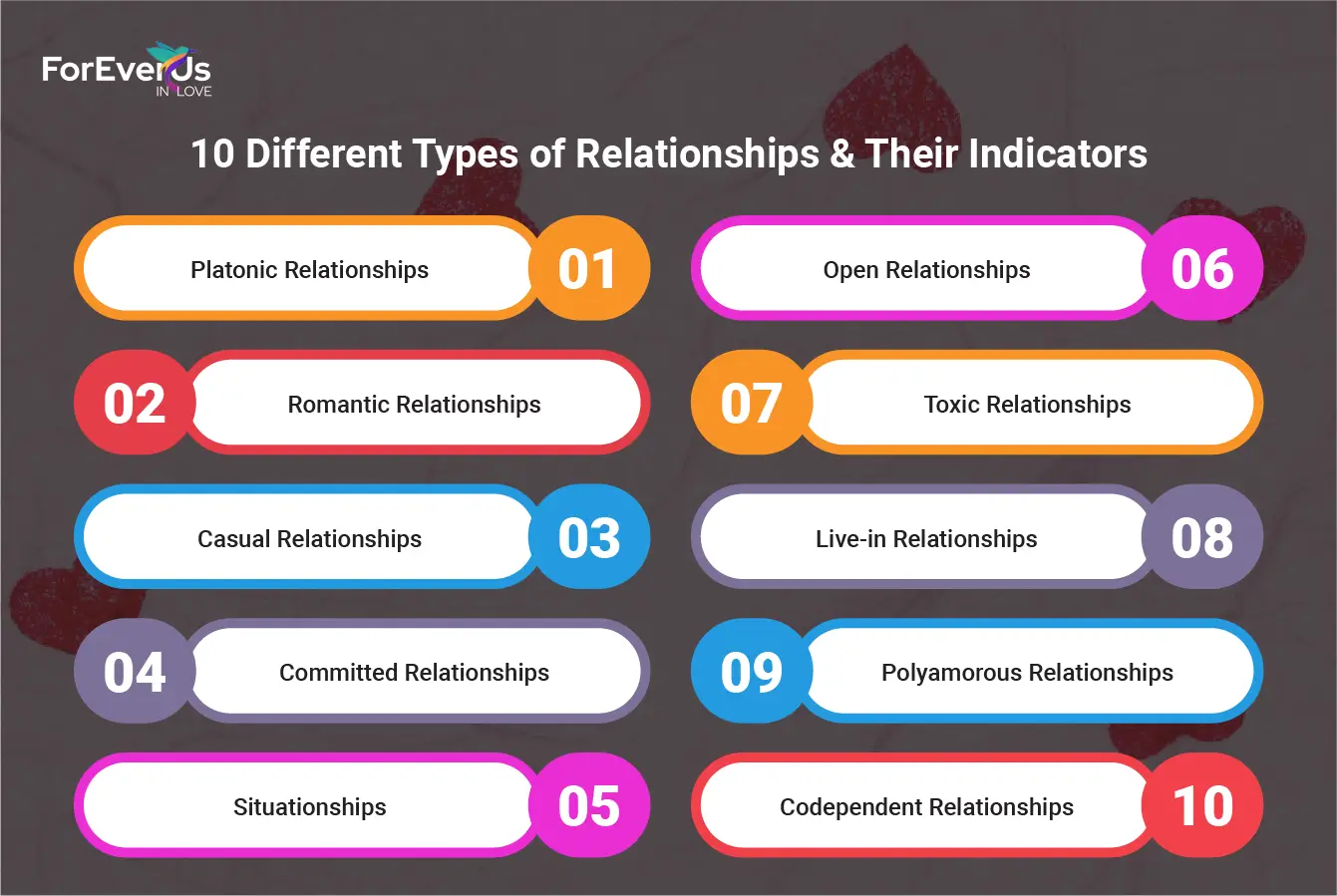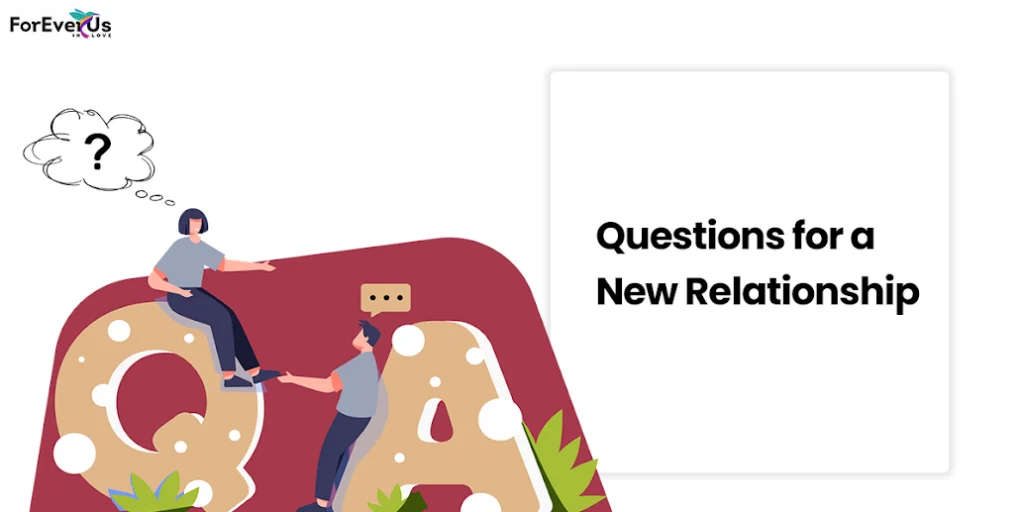Relationships are critical in everyone’s life, whether it’s felt between family members, best friends, or a soulmate, and if everything falls in the right place, it can be the sweetest part of life. However, be it professional, romantic, or friendship, the relationship comes with baggage and has its benefits and challenges.
People use the word “relationship” too much these days and believe that the word contains universal meaning. But it’s not true. There are different forms of relationships, and each type encompasses various meanings and different kinds of human connections.
So, if you are wondering what kind of relationships are there, this detailed blog shares ten types of relationships along with their indicators. So what are you waiting for? Could you scroll down to check out what they are?
What is a Relationship?
Any association or connection between individuals, whether close or distant, constructive or destructive, is referred to as a relationship. When someone refers to “being in a relationship,” they usually mean a particular kind of romantic partnership that involves ongoing emotional and physical intimacy, monogamy (i.e., romantic and sexual exclusivity, wherein members don’t have this type of relationship with anyone else), and some degree of commitment. These partnerships often face various communication challenges as couples navigate their emotional intimacy and expectations.
Love partnerships can come in a variety of shapes and sizes, including marriage, casual dating, and ethical nonmonogamy.
The most important component of any relationship is trust. Read this detailed blog to gain a better understanding of what it means to be in a relationship. These realisations will assist you in comprehending the actual significance of a relationship.
Meet the Different Types of Relationships + Their Indicators
Since all types of relationships are insane and described differently, each relationship affects us uniquely. Just as relationships progress through distinct stages, from initial attraction to deeper commitment, their impact on our lives varies greatly. Like a bunch of flowers where each bloom comes with a different presentation, forms of relationships can also have a similar effect. Here, we have enlisted eleven types of relationships, including their meaning and signs, and know how each form of love or relationship might manifest in one’s life:

1. Platonic Relationships
A platonic relationship is basically a close bond or connection you share with someone who you admire and love deeply but don’t want to indulge in a sexual or physical relationship with. It is all other things related to spirituality, love, care, kindness, affection, and mutual understanding, but there is no desire to engage in physical activities with them.
This type of relationship can be shared between opposite genders, same genders, or non-binary. However, this kind of relationship can turn into spiritual love, wherein both individuals share a next-level connection but without any physical love.
So, more often, platonic relationships can be defined as friendships that are beyond love, depending on the person.
Some indicators of platonic relationships are:
- You enjoy spending time with them but are not attracted to them
- There are some boundaries – you both respect -physical and emotional
- Understanding your relationship is the next level.
- You give space to each other without any interruption.
- You never fantasized about them or thought about hooking up.
- You would not feel jealous if a person were involved in a serious relationship
- You don’t hide anything you do or talk about with them from your soulmate or partner
2. Romantic Relationships
This is the most popular form of relationship and is often characterized as having a deep emotion and physical intimacy between two interested persons in each other and looking forward to building a healthy relationship. From expressing love to communication to commitment, they prioritize their relationship and nurture it with mutual respect and understanding.
In a romantic relationship, partners are usually committed to building a future together, which might include plans for marriage and starting a family. The basis of a romantic relationship is built on trust, communication, and respect towards each other.
Some indicators of romantic relationships are:
- Express love and be ready to communicate on each topic without any limitations or restrictions.
- They are ready to invest in the future together
- Strong emotional and physical relations
- Respected towards their goals and families
- Resolve conflict instantly without getting frustrated or angry
3. Casual Relationships
Living in the online dating era, this is another popular type of relationship where people don’t see their future together and face long-term commitment issues. However, the benefit of a casual relationship is that people enjoy each other’s company without any serious expectations.
The success of these relationships depends on how much you are emotionally and mentally involved. More often, casual relationships are built for fun purposes, and they lack deep and emotional connections. Casual connections are ideal for people who are not ready for serious relationships and are simply looking for companionship without any expectations.
Some indicators of casual relationships are:
- No discussion about the future or long-term plans
- They believe in “let’s enjoy the present, who cares about the tomorrow.”
- Lack of emotional, mental, and financial support
- It avoids frequent messaging and communication
- A clear understanding of boundaries and expectations
4. Committed Relationships
A committed relationship contains a significant level of emotional investment from both partners to maintain and bloom the relationship over the long run. It also includes a mutual agreement to pay attention to each other’s needs and objectives to work together towards a common goal.
Commitment in a relationship typically entails uniqueness, where partners agree not to be involved in sexual relationships with others, and a deep level of loyalty and emotional investment in each other’s lives.
Some indicators of committed relationships are:
- Loyalty and trust levels are at peak.
- Take active participation in decision-making and future planning.
- Ready to support each other mentally and emotionally.
- Mutual efforts to maintain and strengthen relationship.
- Shared responsibilities and goals.

5. Situationships
Situationships refer to an open-ended type of relationship that the two individuals have but cannot clearly describe. There could be some level of physical touch, emotional involvement, or bond, but it should not be as serious as an official partnership or marriage. Situationships are also known to be ambiguous because there is often poor or lack of communication about the nature and direction of the relationship.
Some indicators of situation ships are:
- This is where there is no clear and specific way of describing or even naming the relationship.
- Lack of expectations as to how events, relationships, or goals will develop in the future or the immediate future.
- Uncertainty about the degree of competition exclusion.
- Lack of timely updates or frequent information sharing about the state of the relationship.
- Sometimes, the signs that both people send are contradictory concerning the degree of the relationship.
6. Open Relationships
In open relationships, both individuals in a couple consent to having additional romantic or sexual relations with other people. The secret to swinging can be summed up in the words of the great film – communication, communication, communication with an additional layer of rules and guidelines because this can become quite complex.
Such relationships demand trust and comprehension to successfully manage multiple attachments that do not necessarily eliminate but rather redefine the central connection.
Some indicators of open relationships are:
- High levels of decision-making regarding social interaction with others who are not part of the primary relationship.
- Communication about external relations and their services is as natural and transparent as possible.
- Created clear guidelines about other relationships during engagement and marriage.
- Frequent meetings to resolve all concerns and to express any feelings that the members might have.
- The partners are aware of the involvement and are comfortable with the decision.
7. Toxic Relationships
Thus, toxic relationships refer to the behaviors exhibited in any kind of relationship where these behaviors are negative and destructive to the identities of the people involved. Such relations provide for constant clashes, power struggles, verbal abuse, or otherwise toxic interplay that has a detrimental impact on one.
Some indicators of toxic relationships are:
- High level of disagreement and conflict even on common and small topics.
- Domestic abuse, if it is not physical, then it could be sexual, verbal or psychological abuse.
- Constant feelings of discomfort and unhappiness.
- Lack of trust and respect towards each other.
- Unresolved issues that more often lead to negative behaviour.
8. Live-in Relationships
When two people decide to live together emotionally and physically without any legal formalities or family approval, it is decoded as a live-in relationship.
In a live-in relationship or cohabitation, an unmarried couple lives together like a married couple. From sharing responsibilities to daily routine to splitting expenses, they divide their duties based on their preferences. However, they are allowed to move on if the love somehow disappears in the relationship and things don’t work together.
There are many reasons people today opt for this kind of relationship, especially in urban areas. In fact, more than 48% of young adults have accepted that couples who live together first are more likely to have successful marriages.
Some indicators of live-in relationships are:
- Sharing a living space and responsibilities equally.
- Lack of commitment without getting married
- Developing a shared lifestyle and routine
- Open discussion about anything, including future and family planning
- Balancing personal and professional responsibilities
9. Polyamorous Relationships
Polyamorous relationships consist of consensual non-monogamy, where individuals engage in romantic relationships with multiple partners simultaneously, with the knowledge and consent of each participant. For more insights into polyamorous dating, you can read our detailed guide on polyamorous dating.
In short, it is a relationship type that works for many people. As will all relationships, communication and mutual understanding are key to making it work successfully.
Some indicators of Polyamorous relationships are:
- Open and transparent communication about multiple relationships.
- Consent and awareness from all partners involved.
- Pre-decided boundaries and agreement on relationship dynamics.
- Regular check-ins to ensure the well-being of all partners.
- Respect and honesty for each partner’s needs and feelings.
10. Codependent Relationships
There is typically a significant power imbalance in codependent relationships. Frequently, one individual may be devoting significantly more time, effort, and attention to the other, who either intentionally or inadvertently exploits the circumstance to optimise their wants and requirements. Codependent relationships are typically found in those where one partner suffers from a substance use disorder, although they can occur with anyone, including your family, friends, coworkers, or boss.
At first, it may seem advantageous for both parties when power dynamics are reversed and one person’s needs and wants take precedence over another’s. It feels good to know that you are helping someone else achieve success and pleasure, and it is pleasant to know that you are supporting them.
Some indicators of codependent relationships are:
- Excessive dependency on each other for emotional stability.
- Unable to make decisions individually.
- You need to change who they are.
- It is challenging to explain how you feel about your relationship.
- Sometimes, you face trouble being alone
- Your space doesn’t feel like yours
Key Takeaways
Relationships play an integral part in our lives, shaping emotions, experiences and self-perception. Understanding various types of relationships can help us navigate social situations more successfully, set boundaries, and cultivate positive and fulfilling relationships in our lives. Each type of the above relationship serves an essential function that adds to overall well-being and a sense of belongingness.
FAQs
Is friendship a relationship?
A friendship is a relationship between two people who mutually care about each other, respect each other, and both people trust each other.
What is a symbiotic relationship?
A symbiotic relationship means the same thing – in a healthy or unhealthy way. For instance, extreme dependence on another person can be healthy when both people get benefits, or it can be harmful and codependent if the attachment is driven by fear.
What is a parasocial relationship?
This is the sensation of being close to someone, usually a well-known individual or a made-up figure, without the other person being aware of your existence. Parasocial connections can vary from admiring a celebrity or social media influencer to stalking them or thinking you have a personal relationship with them, such as being married to them.












